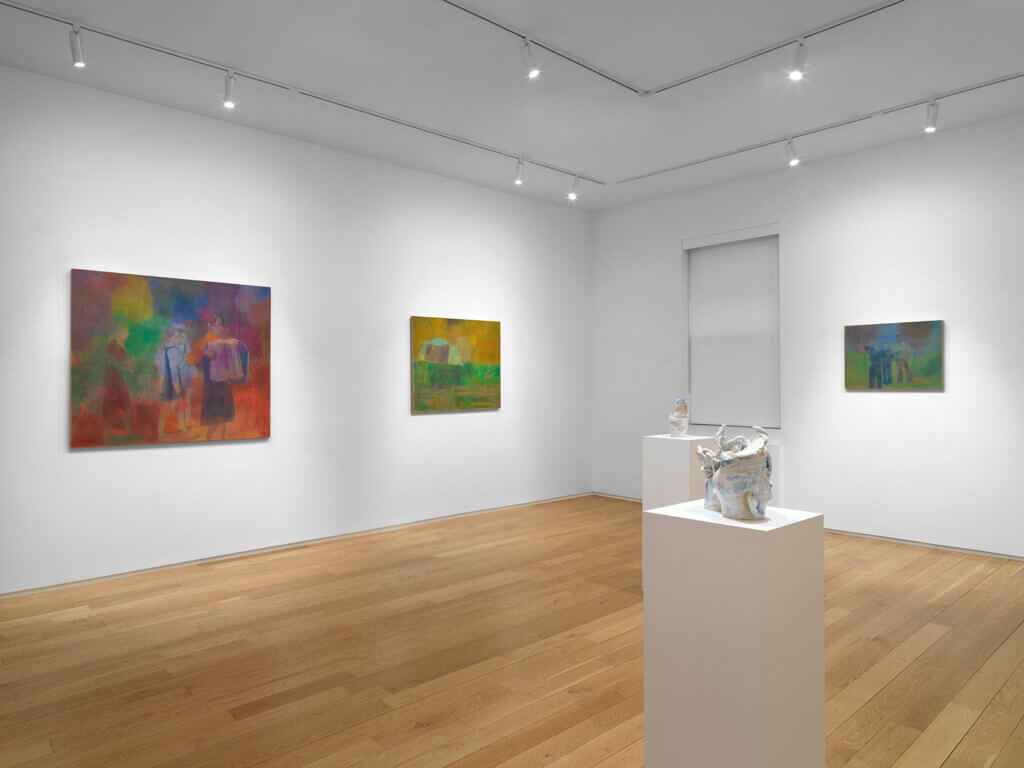
Drew Bennett, Laird Gough, Lyndsey Marko, Alexandria Mento, Dominic Musa, Ben Walker (February 28-March 27, 2024) at Alexander Berggruen, New York.
On the occasion of our exhibition Drew Bennett, Laird Gough, Lyndsey Marko, Alexandria Mento, Dominic Musa, Ben Walker (February 28-March 27, 2024), we spoke with Drew Bennett, Laird Gough, Lyndsey Marko, and Ben Walker about their work.
Drew Bennett, Laird Gough, Lyndsey Marko, Alexandria Mento, Dominic Musa, Ben Walker (February 28-March 27, 2024) at Alexander Berggruen, New York. Video: Xavier Diaz
Oakland-based artist Drew Bennett paints as part of a devotional practice to nature. On his studio wall is the quote: “The landscape reveals itself from within the tree.” The artist is receptive to natural material, both in the subjects he paints and in the wood panels he paints on, working with the wood grain.

Drew Bennett
Emerge, 2024
oil on plywood panel (Doug Fir Veneer)
26 x 48 in. (66 x 121.9 cm.)
Q: How is the way you approach your painting part of your spiritual practice in reverence of nature?
A: I haven’t thought of it so directly before, but for me, spirituality is a relationship with silence. Thoughts are wonderful, but they cloud other more subtle intelligences available to us if we are quiet enough to observe them. These quieter receptors are where spirituality dwells in us. My spiritual practice is based on Vipassana (observational) meditation and my painting practice mirrors Vipassana in that, instead of observing the sensations of the body without craving or aversion, in painting I practice observing the sensations of the eye without craving or aversion. …If it’s a good day 😉
I attempt to practice being still enough of mind to observe visual phenomena at large with greater fidelity, predominantly through contemplating nature. The marks of the painting are an effort to annotate this heightened sensory experience I can’t explain otherwise. The practice of annotating these observations (painting) nourishes me and the depth of my observation. Working perpetually grows the horizon line or goal of the work so the riddle of experience and the effort to articulate it can never be solved. But there is nothing to be solved, just the opportunity to observe with less mind in the way—or with greater silence of mind.
Q: Though the scales of the figures in your paintings Ocean Beach Summer Solstice and Emerge are different, their presence seems to be humbled by the landscapes they are part of. How do you balance a figure’s presence in your compositions?
A: I want to handle various subjects in any painting relatively equally. As humans, we are drawn to what we know, focusing on ourselves first for self preservation and then out of comfort. While I know this to be part of my nature, I want to access a feeling of having given over to the nature of a place. The figures help to support that feeling, but if there were to be a thesis in there, it would be that we enter into nature and become it—well we always are it, but that is not our prevailing worldview these days. The figures in nature are my opportunity to capture the moments most present and profound in my life, but in this moment, I’m realizing that in creating this hierarchy of value of experience, I’m also expressing my world view, cool.
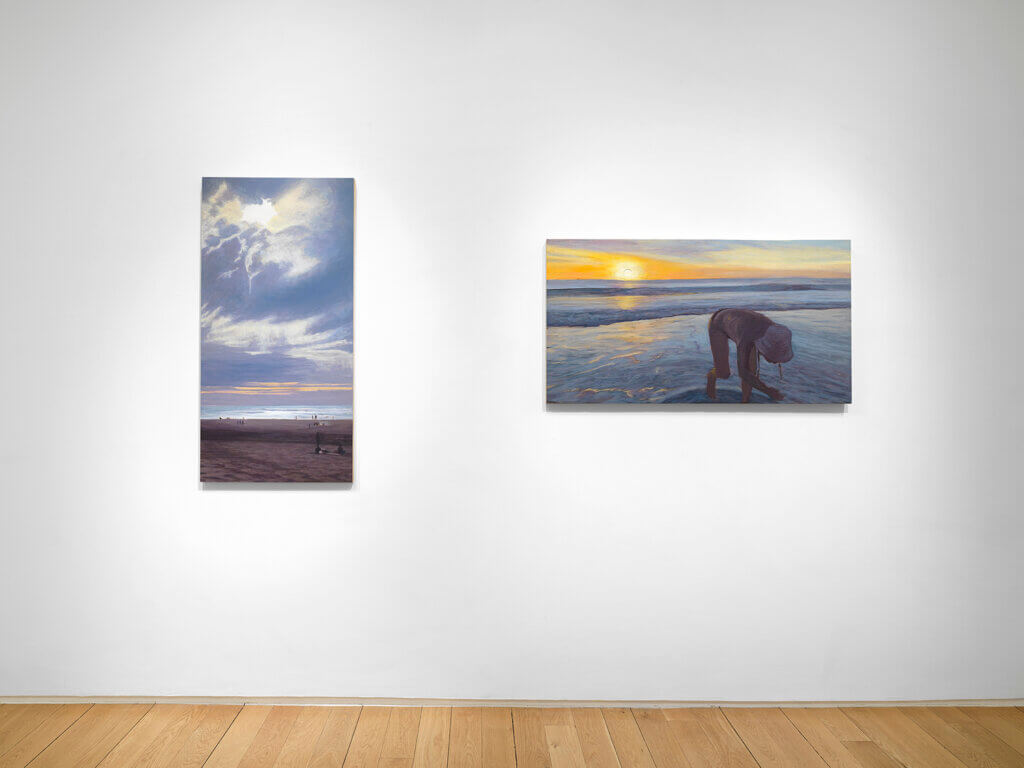
Drew Bennett, Laird Gough, Lyndsey Marko, Alexandria Mento, Dominic Musa, Ben Walker (February 28-March 27, 2024) at Alexander Berggruen, New York.
Q: The form and direction of the light in your painting Emerge is complemented by the wood grain of Doug Fir Veneer panel. Can you share how you aligned the composition with the panel?
A: My process has typically been to build a ‘paint bank’ of images that hold a key to the portal of the soul of the world. I have thousands of images in these folders and files. The most curious images get printed and then they get to interact with the surfaces that I have available. A source image cannot be made into a painting without a fitting substrate. Sometimes the image has to wait a long time for me to find a sympathetic harmony between it and a substrate. Earlier in my career the substrates had more voice, more character, like in Emerge. It’s been a healthy exercise to work on panels with less action on them (more straightforward birch panels) but every time I return to a deeper toned panel, or one with more relief variation, I find it extremely satisfying. Even though the marks are already there, it still feels like I’m giving over to a more collaborative arrangement with the substrate. Not only is it humbling in a way I appreciate, but it also affords more voice to an element of the painting that is often left behind the curtain of paint on the main stage. I find it most satisfying for all the elements—materials, tones, subject matter—to share in the dance of the final performance.

Drew Bennett, Laird Gough, Lyndsey Marko, Alexandria Mento, Dominic Musa, Ben Walker (February 28-March 27, 2024) at Alexander Berggruen, New York.
Through a practice of patience and acceptance, the sculptor Laird Gough embraces the imperfection inherent in humanity and nature. After throwing clay on the wheel, she distorts the vessel, disrupting the symmetry traditionally associated with wheel-thrown ceramics. Where discourse around pottery’s curvature often draws connections to the curves of the human form, the asymmetry in Gough’s work takes this into a fresh, compassionate realm.

Laird Gough
Solstice III, 2024
stoneware with underglaze, glaze, and glass
9 1/2 x 12 x 6 in. (24.1 x 30.5 x 15.2 cm.)
Q: The twists, dents, implants, and bursts of color in your ceramics oscillate between feelings of chaos and order. When are these gestures spontaneous, and when, if ever, are they more planned?
A: These gestures are spontaneous and intuitive, while at the same time taking into account anatomy and the flow of movement in the human body. When shaping two wheel thrown forms together, I think of them as lovers because I see two beings becoming intertwined as one through attraction. I am considering gravitational force and the push and pull of a physical conversation. Once unified, the work can also be viewed from a secondary perspective of the hip and sacral region, where the creation of this energy originates.
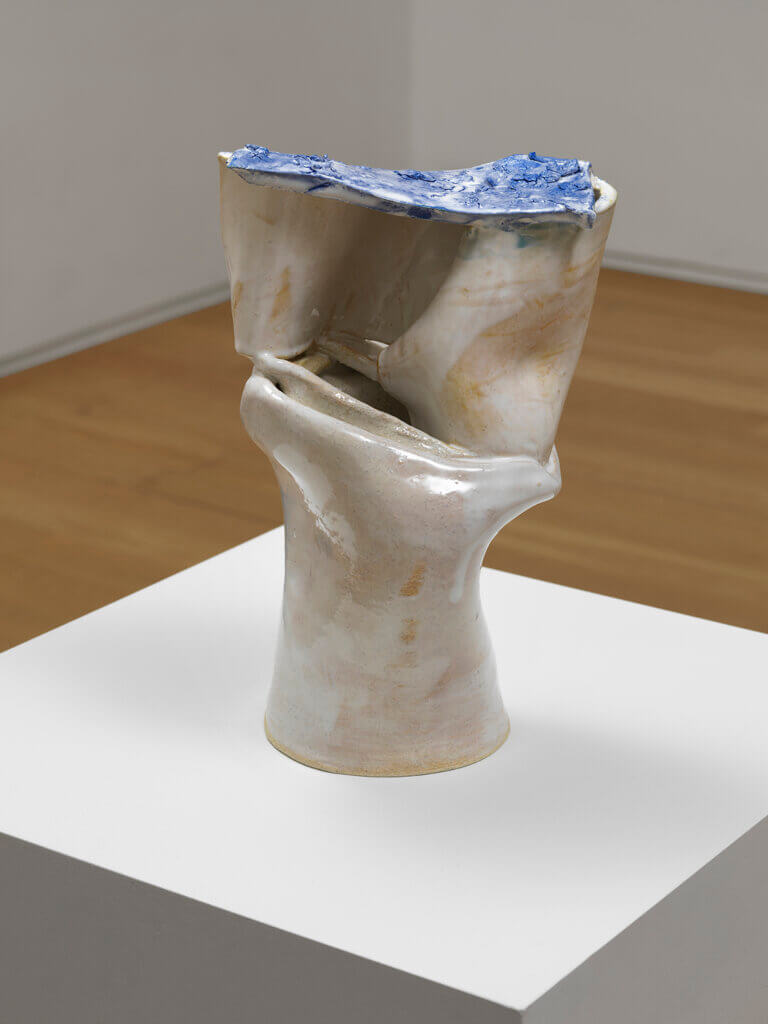
Laird Gough
Solstice I, 2024
stoneware with underglaze and glaze
10 x 6 x 5 in. (25.4 x 15.2 x 12.7 cm.)
Q: Why do you use a paint brush to blend your clay rather than traditional clay tools?
A: Besides my fingers, I like to use a paint brush to blend when sculpting rather than a rake and other traditional clay tools. The bristles of a brush and the manner in which I would hold a brush are both much softer than working with a rigid metal tool, which allows me to soften into the work and not resist the direction the clay wants to take me. There is also meaning for me as a principle that guides my life as softening meaning coming back to oneself. Ultimately, using a soft brush feels more aligned with the feminine energy I am putting into the work.
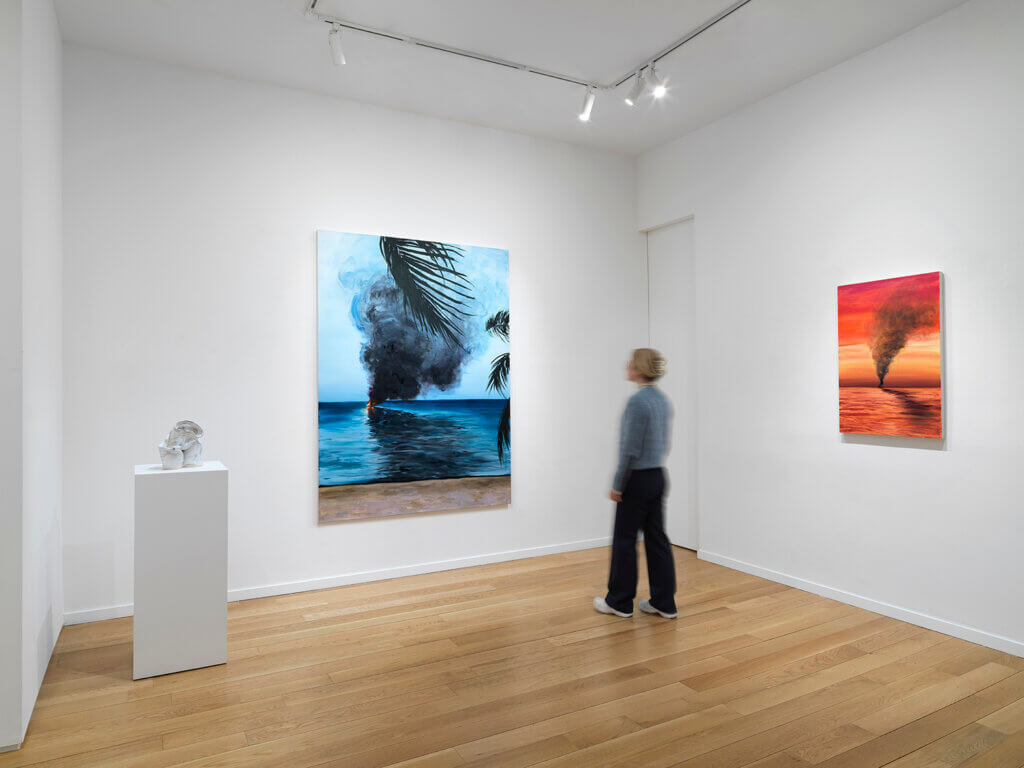
Drew Bennett, Laird Gough, Lyndsey Marko, Alexandria Mento, Dominic Musa, Ben Walker (February 28-March 27, 2024) at Alexander Berggruen, New York.
Boats are aflame in Lyndsey Marko’s paintings. Playfully set against colorful bands of a lambent sky, a shimmering sea, and a strip of sand, the imagined landscapes verge on abstraction. Born and raised in Florida, Marko continually explores her personal experience of seeing a boat on fire as a motif, challenging the unreliable quality of memory.
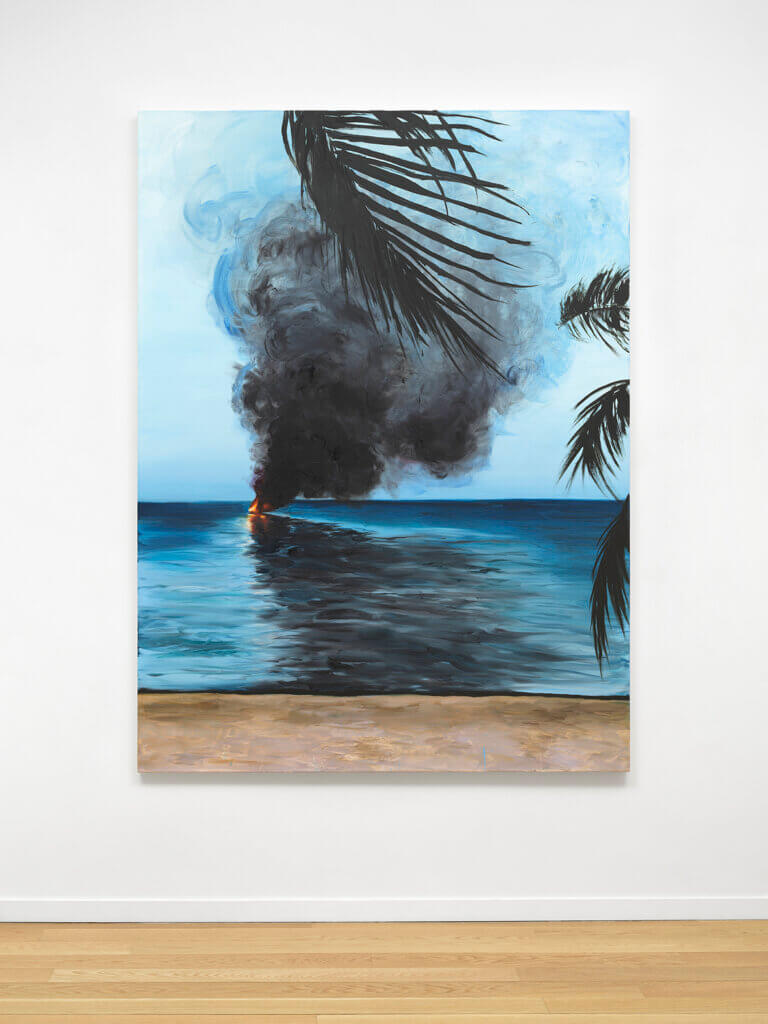
Lyndsey Marko
Trust me, it’s paradise, 2024
oil on canvas
78 x 58 in. (198.1 x 147.3 cm.)
Q: What inspired your title Trust me, it’s paradise?
A: Trust me, it’s paradise is a line taken directly from the movie/book The Beach. The title implies that the viewer needs to be convinced in order to believe in the paradise at hand. The swaying palms, sea and sand are markers of leisure while the vessel in flames indicates immediate peril. Ultimately, the paintings are about seeking a paradise, whether that be a physical or mental space, and whoever is situated on this shore decides how they are implicated in relation to this disaster.

Lyndsey Marko
Double Bind, 2024
oil on canvas
36 x 24 in. (91.4 x 61 cm.)
Q: Your painting Trust me, it’s paradise places a viewer along an implied shoreline and nearby palm trees, whereas your painting Double Bind thrusts a viewer on top of the open sea. To gaze out at the sea is to look far out along the horizon, which can distort the view, and the thick brushstrokes in your paintings contribute to a push and pull between the painted environment and the surface of your work. How do you construct the perspective of your works, and how do you determine where to place a viewer?
A: A double bind is when you’re faced with two courses of action and whichever is taken, unpleasant results cannot be escaped. In Trust me, it’s paradise, the shore gives us a place of respite, and though we are situated on land, the fire on the water is closer and more menacing. We’re not sure what these circumstances mean. The shore and palms are framing devices, allowing the canvas to appear like a window looking out onto the ocean. Double Bind is a jump cut to an alternate viewpoint and different time of day, where the fire is out along the horizon, reduced to clouds of smoke. The viewer is kept more distant, yet there is no place to rest, triggering feelings of uneasiness. In both works, the smoke, water and horizon are confronted formally, allowing the viewer to oscillate between serenity and panic.
Q: The color palettes of Trust me, it’s paradise and Double Bind are quite different from each other. How did your color palettes emerge for these two works?
A: The color palettes in these paintings are indicative of time of day and passing time. Between late afternoon and sunset, the viewer can position themself narratively in relation to the action at hand.
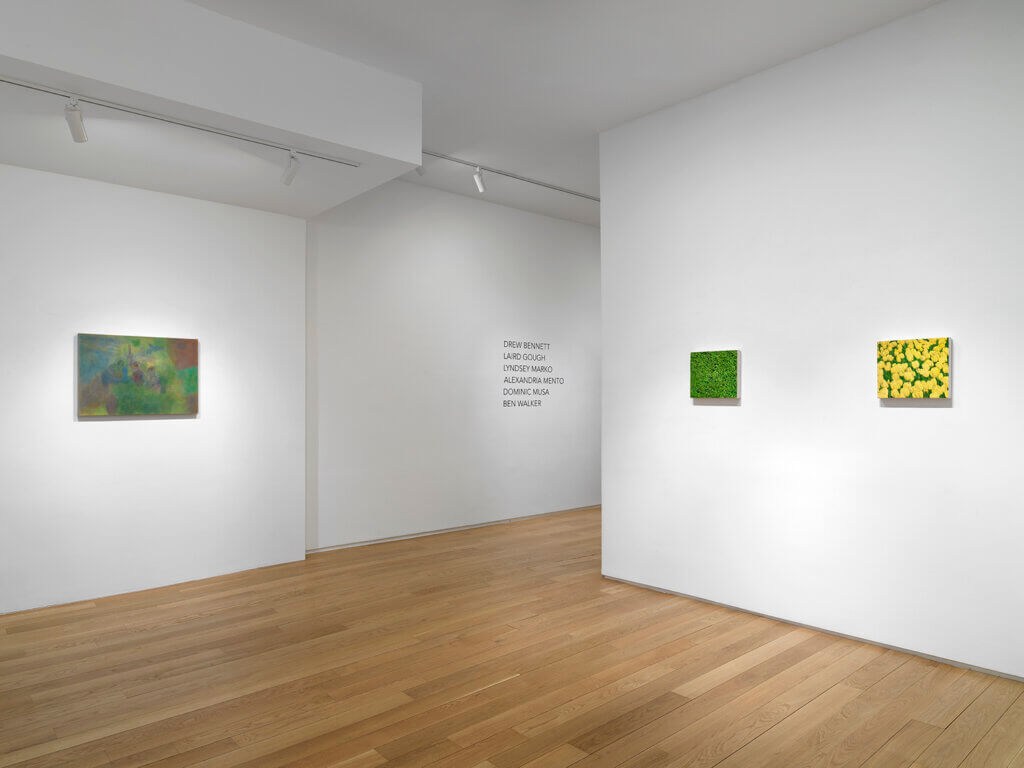
Drew Bennett, Laird Gough, Lyndsey Marko, Alexandria Mento, Dominic Musa, Ben Walker (February 28-March 27, 2024) at Alexander Berggruen, New York.
Alexandria Mento paints hyperrealistic unnatural nature that obscures objects hidden within the painting. Finding the still lives veiled in her work demands a slow pace of looking and an awareness of being physically present, contrary to the common contemporary breakneck pace and the regularity of experiencing life in virtual spaces. As she sources images from datasets fed to computers for machine learning, Mento contemplates the differences in human and computer visual processing.
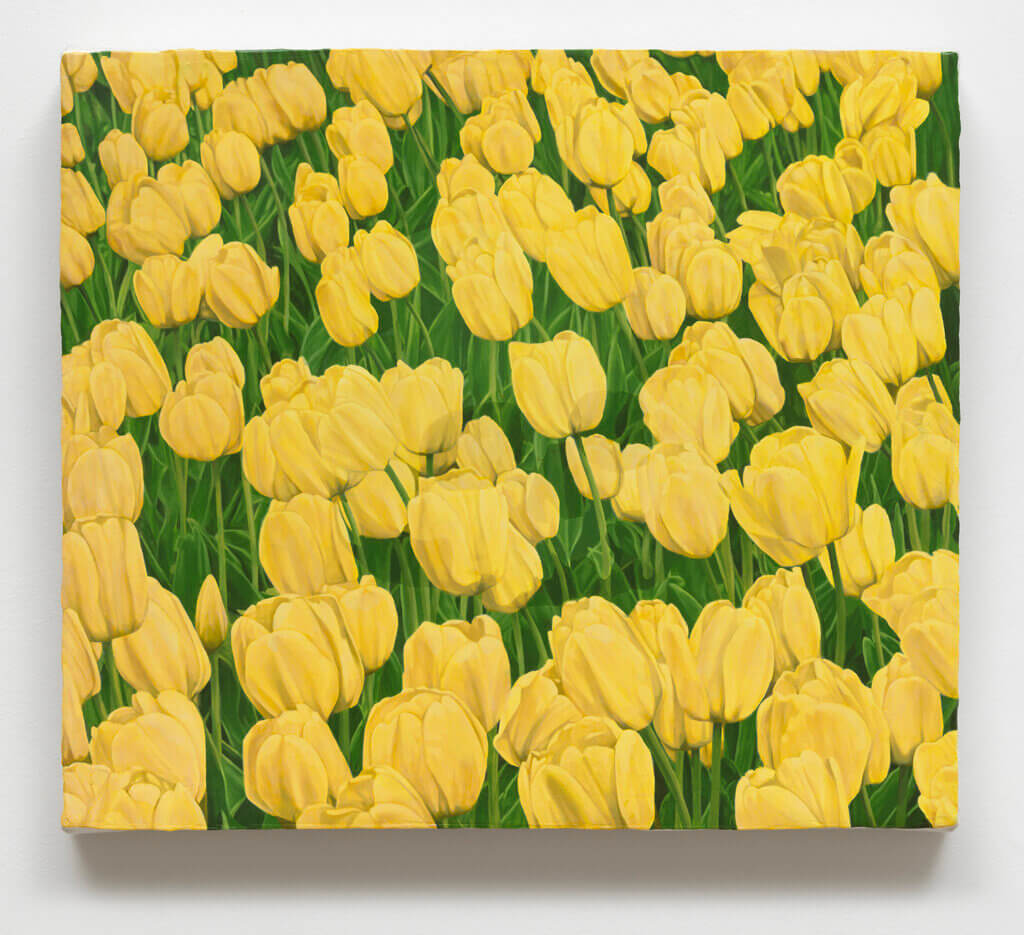
Alexandria Mento
Untitled (Still Life with Skull), 2023
oil on canvas
12 x 14 in. (30.5 x 35.6 cm.)
Q: As these paintings are part of a larger inquiry into still life painting, can you share more about how you see these works in conversation with art historical still life paintings?
A: Still life has a long history of representing our relationship to the immediate object-filled world around us, what we find within these works is that our still touchable realm is embodied with our deeply human associations. In our contemporary moment technology echoes a distilled version of painterly actions as visual learning programs study object recognition which in turn impacts our physical world increasingly more. Here lies so many questions for me it becomes hard to count, all of which I can’t possibly answer and are endlessly inspiring when it comes to painting. As our lives become increasingly virtual, as computers perform seeing for us, as networks change the objects in our lives, how does our intimate relationship to the real change? How does our relationship to vision and perception change? And for me, as a painter, how does this seemingly antiquated and traditional technology of painting change and persist? I think there is plenty of room to reinvent still life here.
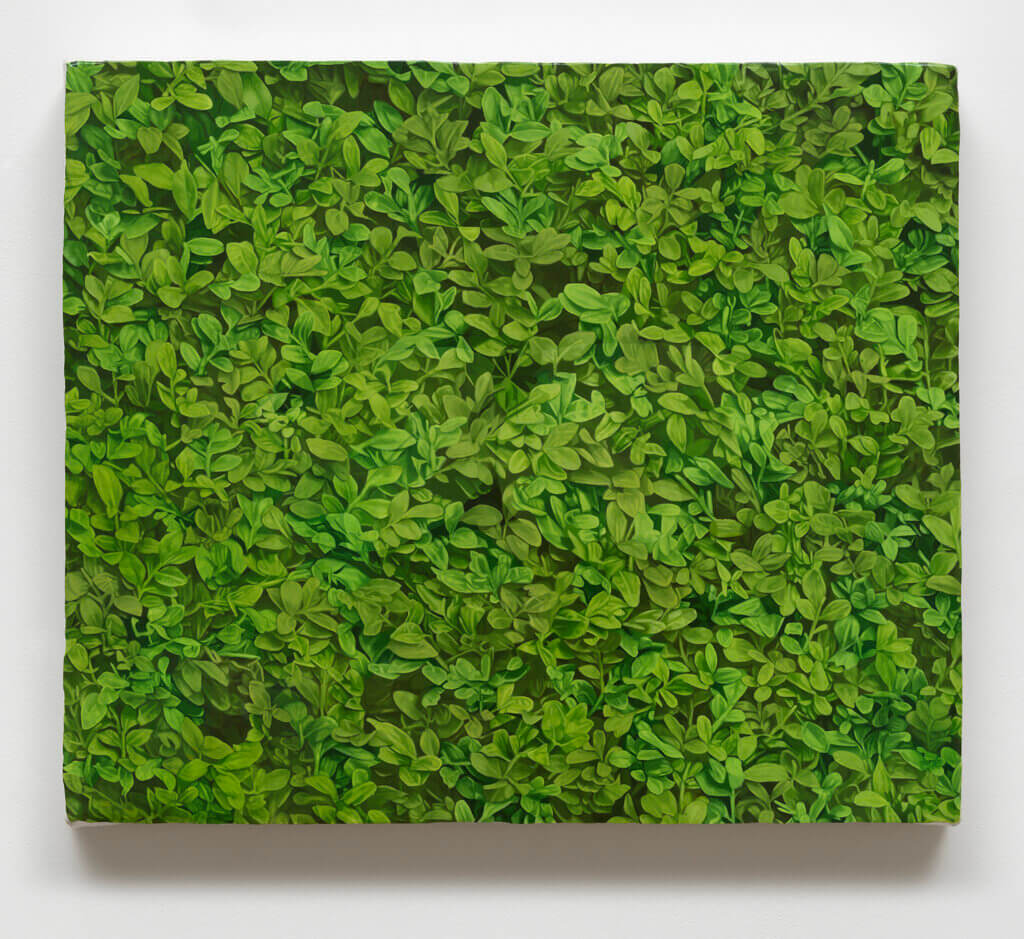
Alexandria Mento
Untitled (Butterfly), 2023
oil on canvas
12 x 14 in. (30.5 x 35.6 cm.)
Q: The imagery you choose, sourced from computer vision training data sets, is of nature, but there is a sterility to them in their farmed perfection and uniformity. Can you tell us about your process of mining these data sets and how you choose the subjects of your paintings?
A: As I search through datasets I am fascinated to see so many varying representations of the world from poor images of things I previously knew to be beautiful, to over-edited images that no longer seem real, and mundane images that seem uniquely shallow. I save so many but the images which seem most urgent can sometimes be the ones which subjects are so familiar to painters, like flowers and foliage. These visuals should feel more honest and tangible but don’t within these images for all these reasons and more. In studying these images I am reminded that our natural world is already deeply affected by programming, whether it has been farmed or landscaped, and that our experiences are shaped through technology on so many levels. To reinsert these painterly subjects back into painting for me feels like an inquiry to find what’s been lost and replaced.
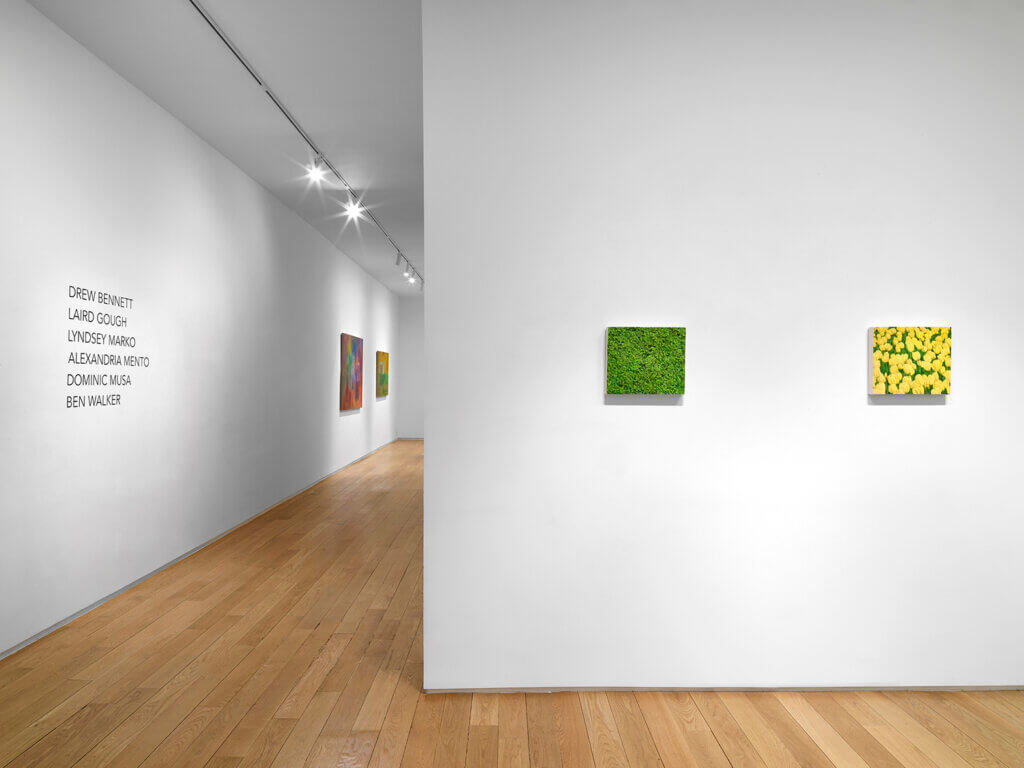
Drew Bennett, Laird Gough, Lyndsey Marko, Alexandria Mento, Dominic Musa, Ben Walker (February 28-March 27, 2024) at Alexander Berggruen, New York.
Q: The surface and level of detail in your work is extraordinarily precise and clean, and the hand of the artist is nearly imperceptible. What draws you to approaching your paintings with this technique?
A: Thank you, I make paintings to be seen in person and so much detail feels lost in reproductions. I handle paint delicately on small canvases in a way that speaks to the intimacy I want these objects to have that can disappear so easily in the everyday. In some ways this feels like making a “high resolution” painting and that I am participating in an act of civil disobedience by performing this labor with my hands. Paintings are so deeply human and above all else I’d like to focus on the unique faculties we all have as individuals who have special capabilities to perceive and feel what we see.
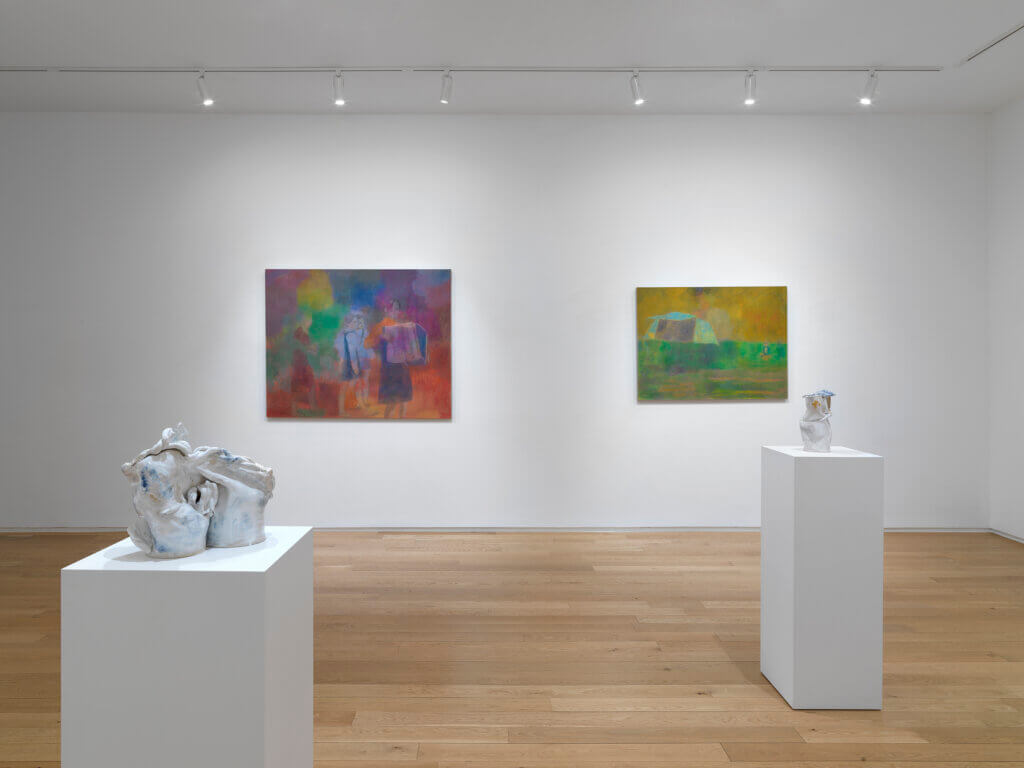
Drew Bennett, Laird Gough, Lyndsey Marko, Alexandria Mento, Dominic Musa, Ben Walker (February 28-March 27, 2024) at Alexander Berggruen, New York.
London-based artist Ben Walker paints from the interstitial ambiguities of memory. With few photos of his childhood, certain pieces of his early memories have lingered in his mind, but the edges are loose and ripe for supplementation with hazy, inaccurate details. These hauntological scenes of figures exist in an often undefined environment where features and details are represented by nebulous swathes of color.
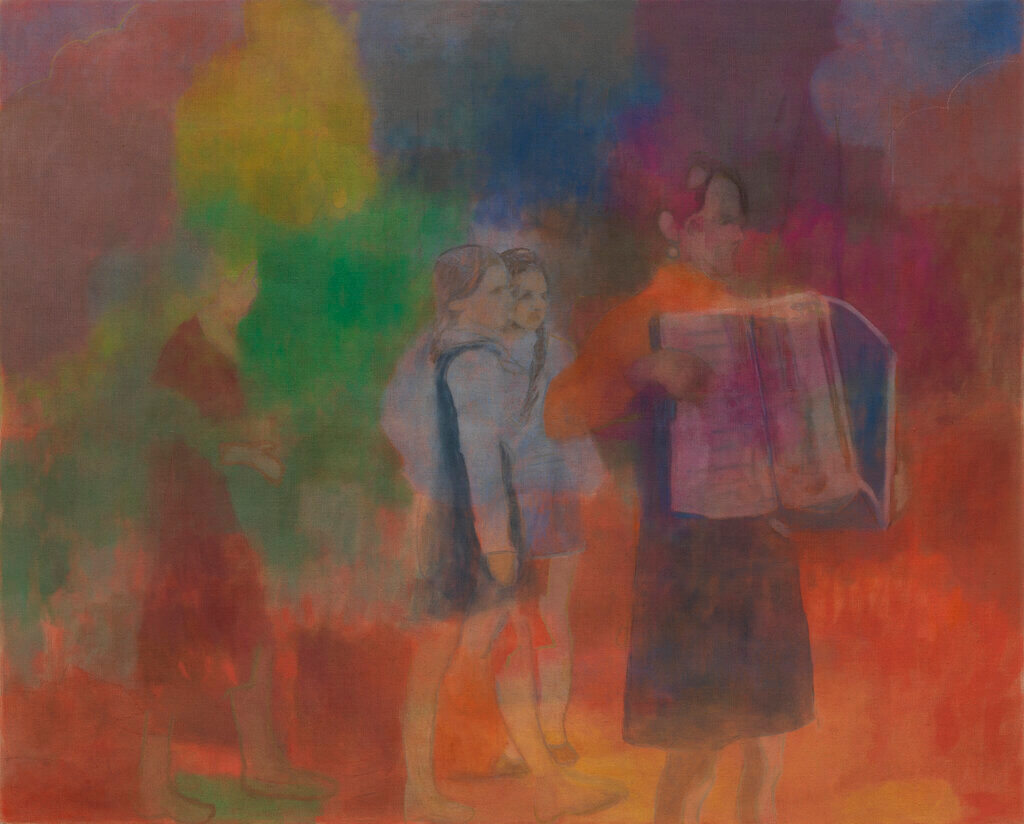
Ben Walker
Soviet, 2023
oil on linen
47 x 58 1/2 in. (119.4 x 148.6 cm.)
Q: The hazy, open-ended qualities of your work lend the paintings an anachronistic and fantastical feeling. Might you be willing to share some of the memories the works in this show are based on?
A: They are based, like most of my work, on imagery from a particular era—the 1970s through to the early 1980s. The imagery is mostly from tv programmes, educational films or books, or just found photos from the era. As a child, my imagination was fueled by the magical childrens’ novels and strange or supernatural tv shows that provided us with a staple diet of early 1980s weirdness. Looking back, these programmes contained something of the uncanny; ordinary mundane settings with eerie happenings. Not really horror, just a sense of something not quite right. With the paintings featuring cub scout camps, it is also about picturing scenes that happened so long ago I start to question whether they even happened. The past begins to feel like another world, and despite the happiness of the period the self-reflection becomes uncomfortable.
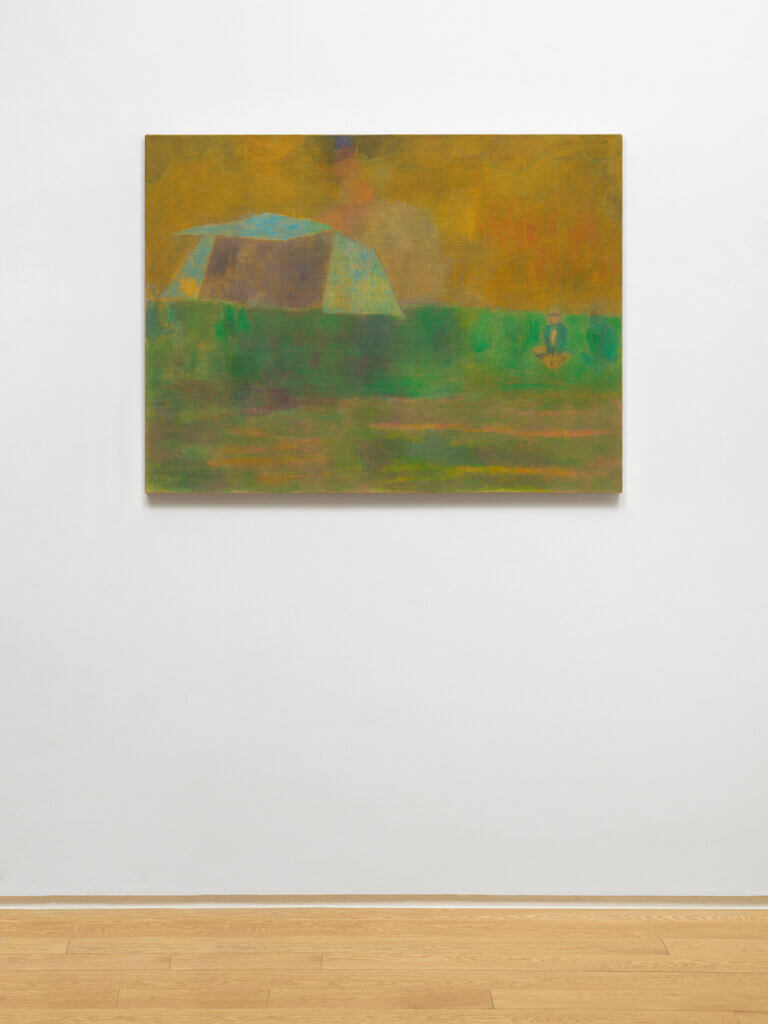
Ben Walker
Pioneer, 2023
oil on linen
36 x 47 1/2 in. (91.4 x 120.7 cm.)
Q: What is the narrative you envision occurring in your painting Pioneer?
A: Pioneer is a picture of a campsite. As a youngster I went on a few Cub Scout camping trips, these were the first times I was away from my parents and family, which was exciting and an important part of growing up and gaining independence. Of course in those days there were no mobile phones or internet, so we would not have had any contact with our parents for the weekend. I don’t remember any anxiety about this, only a lot of fun and misbehaving.
Pioneer started with a Cub Scout leader and 4 boys. After painting several layers of differing colors, and considering elements of the picture as virtually abstract shapes, I felt certain things needed to be removed, that removing parts could bring a pleasing sense of uncertainty to the atmosphere. So eventually only one boy was left, which lent a somewhat poignant or self-reflective air. I gave it the title Pioneer after the Young Pioneers of the Soviet Union, which I was vaguely aware of as a child. The Soviet Union and the Eastern Bloc countries seemed impossibly remote and mysterious, unknowable, I hope maybe this seeps through to the painting.
Q: The edges of your forms often seem to bleed into one another such that although complementary colors are meeting one another, there is no hard edge where one form stops and the other begins. How do you determine which details to keep and which to omit?
A: The decisions about colors and edges come about from years of practice I think, looking at other painters, and establishing a way of painting—building up layers of paint, scrubbing out, and repainting multiple times. I want the paintings to lie somewhere between figurative and abstract. When I use an image as a source, I am trying to use a minimal amount of detail, just enough to make something convincing or believable. It’s a balance between a portrayal of a reality, and creating something that doesn’t already exist. Although I always have an initial composition for each painting, when things are not quite working I’ve learnt to be quite decisive and a new composition will be started over the old one. I’m beginning to learn which details need to be retained to give a painting the presence and believability of form and which can be omitted so it also works as an almost abstract arrangement of shapes and colors.

Ben Walker
Early Experiences (Loss), 2023
oil on linen
22 x 30 in. (55.9 x 76.2 cm.)
Q: There are often surreal colors in your paintings, where a sky may have simultaneous saturated hues at once. How do you choose when to employ more realistic colors and when to diverge from reality?
A: Sometimes I think color is the most important aspect of my paintings, it’s what gives me the most pleasure. I love looking at colors, whether in Fauve paintings, in video or film, or in nature. With the background or skies, generally I build up several layers of colors, starting with warm color. These days I spend more and more time just looking at my paintings, considering what works, what doesn’t, what I could do next. So there is much discovered during the making of the work, and in particular the colors are worked out during the process rather than beforehand. I’m also interested in depicting scenes that are perhaps unreal or dreamlike, so that leads me to employing a combination of naturalistic and heightened/saturated colors. I guess the painting is complete when I’ve finished experimenting with layers of color and reworking and it has a kind of undone or slightly unfinished quality but at the same time just feels ‘right.’
Drew Bennett, Laird Gough, Lyndsey Marko, Alexandria Mento, Dominic Musa, Ben Walker (February 28-March 27, 2024) at Alexander Berggruen, New York.
Artwork and Installation Photos: Dario Lasagni